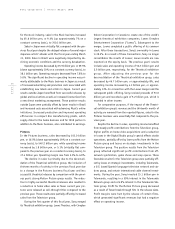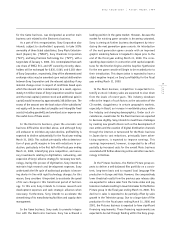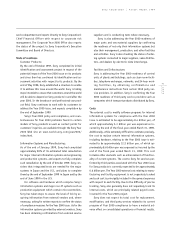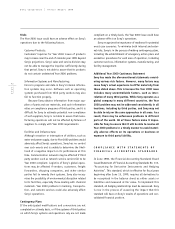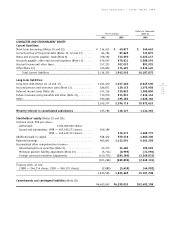Sony 1999 Annual Report Download - page 41
Download and view the complete annual report
Please find page 41 of the 1999 Sony annual report below. You can navigate through the pages in the report by either clicking on the pages listed below, or by using the keyword search tool below to find specific information within the annual report.
Sony Corporation Annual Report 1999
39
page
for the Game business, was designated as another main
business unit related to the Electronics business.
As a part of this reorganization, Sony Corporation also
intends, subject to stockholders’ approvals, to take 100%
ownership of three listed subsidiaries, Sony Music Entertain-
ment (Japan) Inc. (“SMEJ”), Sony Chemicals Corporation
(“SCC”), and Sony Precision Technology Inc. (“SPT”), with a
target date of January 1, 2000. It is contemplated that each
one share of SMEJ, SCC, and SPT owned by minority share-
holders will be exchanged for 0.835, 0.565, and 0.203 share
of Sony Corporation, respectively. (Any of the aforementioned
exchange ratios may be amended upon mutual deliberation
between Sony Corporation and the relevant subsidiary if any
material change occurs in respect of conditions based upon
which the relevant ratio is determined.) As a result, approxi-
mately 33 million shares of Sony Corporation would be issued
and the total capital (common stock and additional paid-in
capital) would increase by approximately 348 billion yen. The
excess of the amount over the book value of the subsidiaries’
net equity will be recorded as tangible and intangible fixed
assets (including goodwill) and amortized as an expense over
the useful lives of these assets.
In the Electronics business, given the economic and
business difficulties described above, and although Sony
will endeavor to minimize any sales decline, profitability is
expected to decline substantially for the fiscal year ending
March 31, 2000. This outlook principally reflects deteriora-
tion of gross profit margins in line with reductions in pro-
duction, particularly in the first half of the fiscal year ending
March 31, 2000, intensifying price competition, and neces-
sary investments relating to digitization, networking, and
expansion of Sony’s alliance strategy for necessary new tech-
nology. During this process of digitization, Sony intends to
maintain high research and development expenses. Sony
understands the life cycle of audiovisual products is becom-
ing shorter in line with rapid technology changes; for this
reason, Sony considers it important to accelerate the speed
of its own changes in this transitional period of technol-
ogy. To this end, Sony intends to increase research and
development expenses and seek strategic alliances when
necessary. Furthermore, Sony intends to accelerate the
streamlining of its manufacturing facilities and supply chain
management.
In the Game business, Sony seeks to promote integra-
tion with the Electronics business. Sony has achieved a
leading position in the game market. However, because the
market for existing game consoles is becoming saturated,
Sony is aiming at further business development by intro-
ducing the next generation game console. An introduction
of the next generation game console with an improved
graphic rendering feature is targeted in Japan prior to the
end of the fiscal year ending March 31, 2000. The corre-
sponding depreciation in connection with capital expendi-
tures for the Emotion Engine and the Graphics Synthesizer
for the new game console will begin to be recorded prior to
their introduction. This depreciation is expected to have a
slight negative impact on Sony’s profitability for the fiscal
year ending March 31, 2000.
In the Music business, competition is expected to in-
tensify as music industry sales are expected to slow down
from the levels of recent years. This industry slowdown
reflects the impact of such factors as the saturation of the
CD market, sluggishness in certain geographic markets,
especially in Brazil, an increase in worldwide piracy within
the industry and changing demographics. Under such cir-
cumstances, overall sales for the Music business are expected
to decrease slightly. Sony intends to meet these challenges
by creating new growth drivers such as the development of
new artists and the creation of digital distribution channels
through the internet. A turnaround for the Music business
in Japan due to cost reductions, principally lower adver-
tising expenses, is expected to improve earnings. This
earnings improvement, however, is expected to be offset
partially by increased costs for the overall Music business
associated with further advancing online and other new tech-
nology initiatives.
In the Pictures business, the Motion Picture group ex-
pects to deliver a well-balanced film portfolio on a consis-
tent, long-term basis and to expand local language film
production in Europe and Asia. However, the comparatively
lower theatrical results from the previous year release slate
are expected to reduce sales from the home video and pay
television markets resulting in lower total sales for the Motion
Picture group in the fiscal year ending March 31, 2000. This
decline in sales is expected to be partially offset by sales
growth in the Television group. Due to a large slate of film
production for the fiscal years ending March 31, 2000 and
2001, the Pictures business is expected to have significant
financing requirements. These financing requirements are
expected to be met through funding within the Sony group.









